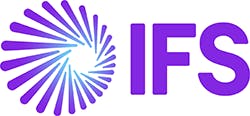Using the cloud to improve your asset management practices
Cloud computing is drastically changing the way many organizations operate. Forward-looking maintenance and reliability teams across industry are starting to explore how the cloud can help them improve their asset management practices.
IFS recently launched IFS Cloud, which is the next step forward from IFS Applications 10 and which enables companies to manage the customer, people, and asset elements of their business in a single solution. During the launch event, Plant Services had the opportunity to speak with Colin Elkins, Vice President of Manufacturing Industries, and learn how IFS Cloud is leveraging artificial intelligence and machine learning to fill some of the pressing needs in manufacturing today.
PS: What innovations in IFS Cloud help differentiate it from previous IFS software releases?
CE: This release is very much an extension of IFS Applications 10. We've taken our IFS Applications 10 product and turned it into a full product designed for the cloud. We didn’t lose any of our 30 years’ worth of functionality, we are extending it. It's the platform for a future strategy.
The first thing that's majorly significant is the interface in Aurena only, which means we are dropping our web client basically to a full Aurena client. Aurena is our native client, which will run in, effectively, any operating system, on any platform, so tablet, mobile phone, as well as the traditional back-office PC applications. So that's the first one, is the fact that we are going directly to the cloud environment.
The second thing is that it is designed for cloud. The whole product has been containerized. We're using Kubernetes as a containerization capability so we can deploy it a lot faster, for a much more evergreen approach. Gone are the days of a product release happening every 18 months to two years with interim patches. This is now a moving feast, and maybe almost the last major product release we will ever have, because from now on it will be an iterative change.
I use the word “platform” because not only have we done it from a product standpoint and functionality standpoint, we've also inserted a services layer within the product architecture. In that layer, we are deploying AI, machine learning, and cognitive services, and we're delivering them as package components. Rather than some of our competitors who treat all of this as a services-led/consultancy-led project, we're aiming to deploy packaged solutions in those automation areas that our customers can take but also can tailor.
For example, within IFS Cloud, we're launching the ability to use machine learning within our forecasting algorithms. For food companies, for example, this means taking weather patterns in, taking social media feeds in, to be able to refine and make those forecasts more accurate.
So that's an example of where there will be a core capability, core service within the application that will deal with that within forecast planning, but also allow our customers to tailor. The focus there is on explainable AI. We're not going there to deliver something that you need data scientists within your organization, it's explainable AI and the point that you can take the services and utilize them throughout the whole application, although we will obviously deliver core capabilities into those areas.
The other thing it's really doing is it's setting us a platform to build more of our other products into a single core product. What I mean by that is we have an approach towards the circular economy. We have a process going now where we're taking the best of our ERP, which we have, the best EAM, which we have, but also taking some of our Gartner tier-one service capabilities and bringing that into the core application.
That doesn't mean to say we're initially dropping field service, it just means that over a period of time, we will migrate a lot of those capabilities into the core product. We believe that if you truly want to address the circular economy, you really have to have everything almost in one place purely to be able to track materials in the field and be able to bring them back via reverse logistics, repair, remanufacture, and put them back into the field. And to do that, we believe we need a single solution.
PS: Do some of those same features also differentiate IFS Cloud from others in the general EAM software market?
CE: There are a lot of what I would call edge applications or core applications that sit on the side of an ERP business solution. We compete against traditional maintenance-type products, but we see maintenance as becoming more into the core application. It's not something that you just schedule the repair of an asset; it's more understanding that asset in the context of manufacturing – making sure that you're scheduling around those manufacturing tasks, that your costings are around those tasks. It's a single purchasing solution whether you're purchasing maintenance spares, or whether you're purchasing for an ERP, or whether you are scheduling labor resources from an HR skills point of view; you're not having to pass that data between two applications.
The other thing from my point of view is it stops what I would call the “edge-edge-core” application. A lot of ERP vendors have a core application, and then you bolt the maintenance product onto the outside of it. But we all know that nowadays there are lots of edge applications that sit around that maintenance product. You end up with an edge application talking to effectively a maintenance product, which is on the edge of the core, which is your ERP, and that becomes extremely complex. You dilute the data, to be honest with you, as you are integrating these products together (which you can do and that's a strategy we have as well using edge applications), but you lose a little bit of the data continuity.
So again, the IFS Cloud strategy is to build the core out with single edge applications rather than having multiple layers . I think that single solution is the mantra, and that's forcing us into other areas like using our own IoT capability, which we've extended in IFS Cloud. We partnered with Crosser, and they will supply the technology to connect to the PLC of the machine. That data is then pumped up into our IoT central controller within the application in the cloud, and we can do one or two things with it from there. We can either take the data and stream that back into the application core as a series of tasks (to update quality spec, update pallet count, etc.); or we're pumping that also into our own data lake, where we're using machine learning on the edge of that data lake to analyze that data, and then come up with the functions and signals we want to push back into the IFS Cloud product.
Rather than having multiple products with a single interface, which is a strategy of some of our other competitors, our strategy is to have a bigger core application and a single user interface.
PS: Let me ask about manufacturers or other customers who might've been working with beta versions of IFS Cloud. Can you talk to the experience of those users?
CE: One of our manufacturing customers that has been an early adopter is Cimcorp.
So far the biggest thing they're saying is the change in user interface is quite dramatic to them, going from very much a forms-based solution like most ERP solutions are, to something that is a little bit more wizard-based. It's a little bit more like going to a website where you'd expect to be taken through a process rather than know the process when you begin it.
Listen to the entire interview
The Aurena interface is trying to get far more to the source of technology that people are used to in their daily lives, and moving away from, “here's a form, you need to know exactly how to fill it in.” It's guiding you and it's bringing a lot more usability to that user interface.
The other thing they've said is having everything in one place, data in one place, access to information, is a lot faster. A lot of that really is IFS Applications 10 as well because functionally core-wise, it's almost the same product. However, there are enhancements that have gone into IFS Cloud.
PS: What features in IFS Cloud should maintenance and reliability know about, or should they be able to take advantage of?
CE: We've been doing maintenance and asset management for 30 years, so from a core functionality, it's a Rolls Royce of the product, it's a very capable product.
I think I stress the word asset management. It's not just a maintenance product, there's more to it than just pure maintenance. We are talking about managing assets and as you know, we talk about an asset being an oil rig, which is far more sophisticated than it just being a CNC machine or a production line within a factory.
I think the key takeaway about it is the MES layer: By putting an IoT strategy in place with a data lake, we are in some respects eliminating that need to put an MES layer in. And I'm not talking ISO 95 here, I'm talking just that sort of data connection to a service on a device to be able to pull data out of it. We cover most of ISO 95 within the ERP product anyway.
Rather than relying on strategies where you say, I'm going to maintain this on a predictive basis every three months or every six months, or I'm going to do on a cyclic count of every so many stampings or so many hours production, we're looking at this far more than taking more data from the device via IoT and using predictive analytics, using machine learning to actually come up with something that is far more robust.
We're honestly more robust but less rigid, which means that you might extend the maintenance cycle by a period of two months. Why replace the head bearing if the head bearing isn't vibrating? Why replace a roller bearing in a conveyor if there's no heat being generated and there's no noise being generated because it's still sound? Having those routine maintenance tasks cost a lot of money, downtime, and parts.
We are currently in the middle of a project with a huge paint manufacturer operating in 45 countries, with 4,500 users, and with them we’re looking at using machine learning for predictive maintenance. They paint ships, giant ships, and one of the things they've been doing is working with their customers to work out the relative speed of the boat through water compared with engine power.
Basically as the antifouling wears off the ship (i.e., the paint), the ship will go slower for the same amount of power, so they've been able to create a software program that their customers use and actually work out this lot of speed and power data. They then can tell the shipowner, “You need to bring Ship Seven into dry dock in two months’ time because the performance of the engine against it through the water is actually now costing you money. It'd be better to repaint it.”
We’re doing the same for them as they've done for their customers, which makes it a kind of really interesting story. This whole area of IoT is just opening up so many new entrants. I read one the other day, which I found fascinating. One of the issues manufacturing companies have always had is connecting a sensor to a machine. How do you know that it's just made a pallet? How do you know that it's just done another stamping?
There's a company, and I think it's in France, who have come up with a sensor, which you literally just bolt to the machine that measures the vibrations. So it knows when the head goes up and comes down again, but that must have actually done the stamping, not by anything other than the fact that there's a vibration change and they can then map the vibration changes to functions and use that as an IoT and MES capability.
I think we're going to see this whole thing boom. As people build more and more sensors in their devices or into the products they sell, I think we're going to see a whole plethora of data, and the cloud is probably the single best way of deploying that data.
Taking a machine down for 4-5 hours is huge, which is why it takes a lot of planning. So extending life cycles of machines, and rather than actually have, what I would call routine maintenance, “because we've always done it,” we're now being able to refine those maintenance tasks using real data to say, "Well, you don't need to yet because it's not going to fail."
PS: You mentioned that IFS Cloud was designed to help improve forecasting by bringing data sets together. Are you seeing customers use IFS Cloud to improve their shutdown and turnaround operations?
CE: Yeah. I mean, that's the reason for it. Going back to the example with the ship painter, that's what they've done: you don't paint the ship until you need to. With machine learning, you don't take the plant down until the machine learning program tells you that you need to take the plant down. I think ML ultimately will extend the life of assets, which will increase OEE and all the benefits you get out of having plants up and not suddenly having to schedule a maintenance crew when it's not needed.
PS: Given that IFS Cloud is more of a platform than a product, what might be next in IFS’ strategic roadmap?
CE: It’s all about the circular economy, the fact that service, maintenance, asset management, and manufacturing are all really starting to come together now. Manufacturers out there are redesigning their products; they're looking a little bit more at the energy being used when they manufacture a product.
A machine is no longer just something that makes something. A machine starts to become something that adds to the cost of manufacturing. It's not as simple as an overhead that's applied generally within the financial ledgers anymore. It's something where you can take a real look at what you're doing.
We have a company in Sri Lanka who make tires. Now, Sri Lanka is a country that is bereft of water in some respects, where water is a real commodity, so they've started to really look at what they do by designing processes that use less water in their manufacturing cycles. You only do that by looking at the assets you've got and how you manage them, and more importantly, how much they're costing you and specifically how much they're costing you when you manufacture products. I think a lot of the things we're putting into IFS Cloud play much to that by bringing the data all into one source, so you can track materials and keep them in the economy for as long as possible.
There are some big functional changes coming. One is in the area of planning, specifically for the food and beverage industry where we're really looking to address what I would classify as the day one for one scenario daily planning. We’re getting away from the planning in days to much more planning in hours, and planning production cycles to meet lorry dispatch times, really bringing that granularity down, which is something that I don't think many ERP vendors do. We tend to operate a little bit above that layer and let MES systems and various paperwork systems basically handle the rest, and we're really looking to put some functionality in there.
We're really concentrating on this services layer, and have two projects going that are key to us. One is for the machine learning product, and the other is about taking data that is not in a readable form or an easily understandable form into an understandable form using cognitive services – actually being able to take data that would be in a manual or a set of notes or a video or a soundbite, and turn that into data that we can use to orchestrate machine learning. Plus, with this release, we're launching our own business process management, our own fully-integrated workflow engine within the product, extending our existing capabilities.
The big sound bite coming from R&D really is “lockdown the core, extend on the outside.” Our focus is still on making that core as big and broad as we can so our customers can get maximum use out of an edge application rather than having it as an edge on an edge, on a core.


